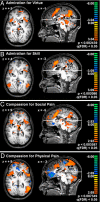Neural correlates of admiration and compassion
- PMID: 19414310
- PMCID: PMC2670880
- DOI: 10.1073/pnas.0810363106
Neural correlates of admiration and compassion
Abstract
In an fMRI experiment, participants were exposed to narratives based on true stories designed to evoke admiration and compassion in 4 distinct categories: admiration for virtue (AV), admiration for skill (AS), compassion for social/psychological pain (CSP), and compassion for physical pain (CPP). The goal was to test hypotheses about recruitment of homeostatic, somatosensory, and consciousness-related neural systems during the processing of pain-related (compassion) and non-pain-related (admiration) social emotions along 2 dimensions: emotions about other peoples' social/psychological conditions (AV, CSP) and emotions about others' physical conditions (AS, CPP). Consistent with theoretical accounts, the experience of all 4 emotions engaged brain regions involved in interoceptive representation and homeostatic regulation, including anterior insula, anterior cingulate, hypothalamus, and mesencephalon. However, the study also revealed a previously undescribed pattern within the posteromedial cortices (the ensemble of precuneus, posterior cingulate cortex, and retrosplenial region), an intriguing territory currently known for its involvement in the default mode of brain operation and in self-related/consciousness processes: emotions pertaining to social/psychological and physical situations engaged different networks aligned, respectively, with interoceptive and exteroceptive neural systems. Finally, within the anterior insula, activity correlated with AV and CSP peaked later and was more sustained than that associated with CPP. Our findings contribute insights on the functions of the posteromedial cortices and on the recruitment of the anterior insula in social emotions concerned with physical versus psychological pain.
Conflict of interest statement
The authors declare no conflict of interest.
Figures



Comment in
-
Finding the self in self-transcendent emotions.Proc Natl Acad Sci U S A. 2009 May 12;106(19):7687-8. doi: 10.1073/pnas.0903076106. Epub 2009 May 5. Proc Natl Acad Sci U S A. 2009. PMID: 19416850 Free PMC article. No abstract available.
Similar articles
-
Hippocampal contributions to the processing of social emotions.Hum Brain Mapp. 2013 Apr;34(4):945-55. doi: 10.1002/hbm.21485. Epub 2011 Oct 20. Hum Brain Mapp. 2013. PMID: 22012639 Free PMC article.
-
The embodiment of emotion: language use during the feeling of social emotions predicts cortical somatosensory activity.Soc Cogn Affect Neurosci. 2013 Oct;8(7):806-12. doi: 10.1093/scan/nss075. Epub 2012 Jul 13. Soc Cogn Affect Neurosci. 2013. PMID: 22798396 Free PMC article.
-
Is emotional contagion special? An fMRI study on neural systems for affective and cognitive empathy.Neuroimage. 2008 Nov 15;43(3):571-80. doi: 10.1016/j.neuroimage.2008.08.014. Epub 2008 Aug 26. Neuroimage. 2008. PMID: 18790065
-
Upregulating positive affect through compassion: Psychological and physiological evidence.Int J Psychophysiol. 2022 Jun;176:100-107. doi: 10.1016/j.ijpsycho.2022.03.009. Epub 2022 Mar 28. Int J Psychophysiol. 2022. PMID: 35358613 Review.
-
The plasticity of social emotions.Soc Neurosci. 2015;10(5):466-73. doi: 10.1080/17470919.2015.1087427. Epub 2015 Sep 15. Soc Neurosci. 2015. PMID: 26369728 Review.
Cited by
-
Functional Polymorphisms in Oxytocin and Dopamine Pathway Genes and the Development of Dispositional Compassion Over Time: The Young Finns Study.Front Psychol. 2021 Apr 8;12:576346. doi: 10.3389/fpsyg.2021.576346. eCollection 2021. Front Psychol. 2021. PMID: 33897514 Free PMC article.
-
Praising others differently: neuroanatomical correlates to individual differences in trait gratitude and elevation.Soc Cogn Affect Neurosci. 2018 Dec 4;13(12):1225-1234. doi: 10.1093/scan/nsy093. Soc Cogn Affect Neurosci. 2018. PMID: 30351412 Free PMC article.
-
Empathic Care and Distress: Predictive Brain Markers and Dissociable Brain Systems.Neuron. 2017 Jun 21;94(6):1263-1273.e4. doi: 10.1016/j.neuron.2017.05.014. Epub 2017 Jun 8. Neuron. 2017. PMID: 28602689 Free PMC article.
-
Aberrant Insula-Centered Functional Connectivity in Psychogenic Erectile Dysfunction Patients: A Resting-State fMRI Study.Front Hum Neurosci. 2017 May 16;11:221. doi: 10.3389/fnhum.2017.00221. eCollection 2017. Front Hum Neurosci. 2017. PMID: 28559803 Free PMC article.
-
Distinct brain mechanisms for conscious versus subliminal error detection.Neuroimage. 2013 Jun;73:80-94. doi: 10.1016/j.neuroimage.2013.01.054. Epub 2013 Feb 4. Neuroimage. 2013. PMID: 23380166 Free PMC article.
References
-
- Haidt J. The emotional dog and its rational tail: A social intuitionist approach to moral judgment. Psychol Rev. 2001;108(4):814–834. - PubMed
-
- Greene JD, Sommerville RB, Nystrom LE, Darley JM, Cohen JD. An fMRI investigation of emotional engagement in moral judgment. Science. 2001;293(5537):2105–2108. - PubMed
-
- Davidson RJ, Harrington A, editors. Visions of Compassion: Western Scientists and Tibetan Buddhists Examine Human Nature. New York: Oxford Univ Press; 2002.
-
- Haidt J. Elevation and the positive psychology of morality. In: Keyes CLM, Haidt J, editors. Flourishing: Positive Psychology and the Life Well-Lived. Washington, DC: Am Psychol Assoc; 2003. pp. 275–289.
Publication types
MeSH terms
Grants and funding
LinkOut - more resources
Full Text Sources
Research Materials

